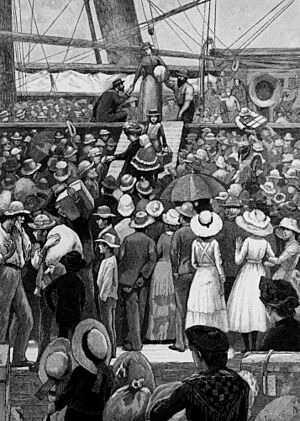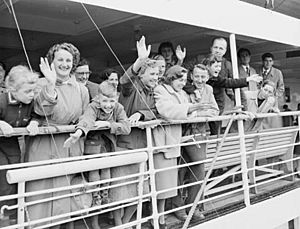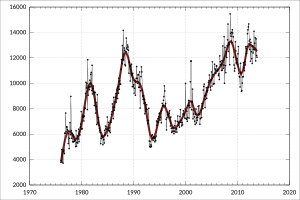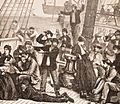Immigration history of Australia facts for kids
The immigration history of Australia tells the story of how people have come to live on this continent over many thousands of years. It began about 80,000 years ago when the ancestors of Aboriginal Australians first arrived. They travelled from islands in Maritime Southeast Asia and New Guinea. Later, in the early 1600s, European explorers started visiting the coast.
Permanent European settlement began in 1788. This was when Britain set up a British penal colony (a place for prisoners) in New South Wales. After Australia became a united country in 1901, it had a policy called the White Australia Policy. This policy limited who could come to Australia. It was removed after World War II, leading to Australia becoming a multicultural country. Since the late 1970s, many more people have come from Asian and other non-European countries.
Australia also follows the Convention Relating to the Status of Refugees, which means it helps people seeking safety from their home countries.
Contents
First Australians: The Original Inhabitants
The very first people in Australia were the ancestors of today's Aboriginal and Torres Strait Islander people. Scientists are still debating exactly when they arrived, but it was at least 40,000 to 43,000 years ago, and possibly even earlier, up to 70,000 years ago.
These first journeys happened during the Ice Age. At that time, sea levels were much lower. Australia and New Guinea were joined together as one big landmass called Sahul. This land was connected by a wide land bridge.
It's thought that these early people sailed shorter distances between islands to reach Sahul. Then, they walked across the land bridge to spread out across the continent. Evidence shows humans lived near the Swan River in Western Australia about 40,000 years ago. Tasmania, which was also connected by a land bridge then, was reached at least 30,000 years ago.
As the Ice Age ended about 10,000 years ago, sea levels rose again. Australia became a separate island once more. However, the Torres Strait still allowed people to trade and connect between New Guinea and the northern Cape York Peninsula.
Thousands of years ago, the Melanesian Torres Strait Islanders settled in the Torres Strait Islands. They continued trade and contact with New Guinea. There was also some contact along Australia's northern coast by sailors from places like Macassar (in Indonesia). These visits didn't lead to large groups of non-Aboriginal people settling in Australia before Europeans arrived.
A recent study from Germany looked at the DNA of Indigenous Australians. It suggests that a group of migrants from India arrived in Australia about 4,230 years ago. This was long before Captain James Cook explored the Australian coast. The study found that up to 11% of Aboriginal Australians' DNA might come from these Indian migrants. During this time, dingos also first appeared in Australia. This suggests the Indians might have brought dingoes with them. They might also have brought new stone tools called microliths.
This study changes the idea that Australia was completely isolated after its first settlers arrived. Scientists believe the DNA link could mean people travelled directly from India to Australia. Or, it could mean genetic material slowly spread through contact between different groups of people. This Indian influence might have helped shape the Australian Aboriginal culture.
British Settlement: 1787-1800s
After losing the American colonies, Britain's prisons became very crowded. To solve this, Britain decided to send its prisoners to Australia. In 1787, the First Fleet sailed to Australia. It had 11 ships and about 1,350 people, led by Captain Arthur Phillip. On January 26, 1788, they landed at Sydney Cove. The new colony of New South Wales was officially declared on February 7.
More ships brought convicts and free settlers. Convict transportation to Sydney stopped in 1840. It continued for a few more years to Van Diemen's Land (now Tasmania) and Moreton Bay (now Queensland). Perth, in Western Australia, was started by free settlers in 1829. It struggled and later asked for convicts. However, South Australia (with its capital Adelaide, founded 1836) and Victoria (with its capital Melbourne, founded 1839) were settled only by free people. By 1868, when convict transportation ended, about 165,000 people had arrived in Australia as convicts.
From about 1815, Sydney grew quickly as free settlers arrived from Britain and Ireland. New lands were opened for farming. Despite the long sea journey, people were attracted by the chance to start a new life on cheap land. Many settlers took land without official permission; they were called squatters. They became a powerful group of landowners.
The discovery of gold in 1851 changed Australia a lot. Gold was found near Bathurst in New South Wales, and then in Victoria. These gold rushes happened after a big economic problem worldwide. Because of this, about 2% of people from Britain and Ireland moved to New South Wales and Victoria in the 1850s. Many people also came from Europe, North America, and China.
In 1851, Australia's population was 437,655. Ten years later, it had grown to 1,151,947. This fast growth was mostly due to the gold rushes.
In the late 1800s, some Australian colonies paid for skilled immigrants from Europe to come. For example, German winemakers were helped to settle in South Australia. Governments found they had to help pay for travel because Australia was so far away. This made it more expensive and less appealing than Canada or the United States.
The number of immigrants could be controlled by changing how much help was given. Before Australia became a united country in 1901, colonial governments helped pay for passages. The British government paid for convicts, soldiers, and government workers. Few immigrants received help before 1831. In Queensland, many immigrants passed through the Yungaba Immigration Centre in Brisbane.
| Period | Australia | NSW | Vic | Qld | SA | Tas | WA |
|---|---|---|---|---|---|---|---|
| 1831–1860 | 18,268 | 5,355 | 8,796 | 479 | 2,728 | 710 | 200 |
| 1861–1900 | 10,087 | 1,912 | 1,304 | 5,359 | 1,161 | 119 | 232 |
Early Federation: 1901-1945
One reason Australia became a united country (federated) was to have one common immigration policy. There was strong opposition to Chinese immigration and to using workers from New Caledonia in the Queensland sugar industry.
The White Australia policy meant that most non-European people were not allowed to immigrate to Australia. This was the official policy of all governments and major political parties from the 1890s to the 1950s. Parts of the policy lasted until the 1970s. Even though "White Australia Policy" was not an official name, it was commonly used in public discussions.
Australia was a mostly European nation close to Asia. Many white Australians feared being outnumbered by the large populations in Asian countries to the north. After the attacks on Darwin by Imperial Japan in World War II, the Minister of Immigration, Arthur Calwell, said in 1947: "We have 25 years at most to populate this country before the yellow races are down on us." This worry about Australia's small population was a big reason for the huge immigration program from Europe after the war.
Post-War Immigration
After World War II, Australia believed it needed more people to avoid the threat of another invasion. It started an immigration program with the slogan "populate or perish" (meaning, get more people or risk disappearing). Hundreds of thousands of displaced Europeans moved to Australia. More than three million people immigrated from Europe between the late 1940s and the 1960s. The Immigration Minister, Arthur Calwell, started the Assisted Passage Migration Scheme in 1945. The government wanted to increase Australia's population, especially with people who had skills for growing industries.
Australia first looked to Britain for migrants. The assisted immigration scheme was popular with young couples and single people. It was cheap, an adventure, and an opportunity. But after only a year, there weren't enough ships, and numbers dropped. Australia then took a big step and looked outside Britain for migrants for the first time. In 1947, Calwell agreed to bring 12,000 people each year from Estonia, Latvia, Lithuania, and Poland. Many of these were refugees helped by the International Refugee Organisation (IRO). They were accepted for humanitarian reasons, but they had to stay in Australia for two years and work in government-chosen jobs. From the end of World War II until 1954, 182,159 people were sponsored by the IRO to resettle in Australia from Europe.
Over the next twenty years, immigration patterns kept changing. The government encouraged more people to come, and more agreements were made with different countries. In the late 1950s, more immigrants started to be accepted from the Middle East. In 1958, under the Migration Act 1958, a "dictation test" (used to keep non-Europeans out) was removed. A new universal visa system was introduced. This allowed non-Europeans to immigrate based on what they could offer Australia and if they could fit into Australian society. This attracted many professionals and skilled people who helped Australia's growing service industries.
The Australian government helped many refugees, for example, by helping them find work. This was possible because the economy was growing, and there were big building projects like the Snowy Mountains Scheme. This growth in immigration greatly changed Australia's image. Before the war, Australian society was mostly Anglo-Saxon (from Britain). Immigration rules were still strict about non-Europeans because of the White Australia Policy.
The White Australia Policy began to be removed in 1966, under Prime Minister Harold Holt. The last parts of the policy were finally abolished in 1973 under the government of Gough Whitlam.
Modern Era
During the 1970s and 1980s, about 120,000 refugees from southern Asia moved to Australia. During these twenty years, Australia started to adopt a policy called "multiculturalism". This idea was promoted by Minister of Immigration Al Grassby. Australia's multicultural policy was greatly shaped by the Galbally Report of 1978. This report looked at how to live in and plan for a multicultural Australian society.
Immigration to Australia in the late 20th century was affected by several world events:
- The fall of Saigon in 1975 led to many people from Indo-China moving to Western countries, including Australia.
- The fall of East Timor to Indonesian troops in 1975 caused many East Timorese to seek safety in Australia.
- Dictatorships in South America in the 1970s led political activists from Chile, Argentina, and Uruguay to flee to Australia.
- The Lebanese Civil War (1975-1990) brought many Lebanese refugees to Australia.
- The Tiananmen Square massacre in June 1989 resulted in many Chinese students in Australia being allowed to stay permanently.
- The Yugoslav Wars in the Balkans (1991–2001) caused many Albanians, Bosnian Muslims, Croats, and Serbs to settle in Australia.
- The Jakarta riots of May 1998 led to people from Jakarta moving to major Australian cities.
In 1994-1995, Australia accepted 87,000 immigrants. In 2004-05, Australia accepted 123,000 new settlers, a 40% increase over 10 years. Most immigrants (40,000 in 2004/05) moved to Sydney. The largest groups came from Asia, especially China and India. There was also a big increase in students from Asia, and many tourists from Asia continued to visit. The planned number of immigrants for 2005-06 was more than double the number from 1996.
By 2007, immigration accounted for just over half of Australia's population growth. In New South Wales and South Australia, about three-quarters of the population growth came from immigration. The planned intake for 2007-08 was almost 153,000, plus 13,000 under the humanitarian program. Also, 24,000 New Zealanders were expected to move under a special agreement.
Since the 1988 Fitzgerald Inquiry, Australia has increased the number of skilled and business migrants. This is compared to the number of family reunions. Refugees who are given a protection visa can receive standard social security benefits, like unemployment payments and rent assistance.
Asylum Seekers
In the early 1990s, Australia's immigration laws changed a lot. They introduced "mandatory detention" for people who arrived without permission, often called "boat people". When more unauthorized boats arrived in the late 1990s, mostly from war-torn countries like Iraq and Afghanistan, the Howard government continued this policy. This gained international attention during the Tampa affair in 2001.
During the 2001 election, immigration and border protection became a very important topic. This was due to events like the Tampa affair, the Children overboard affair, and the sinking of the SIEV-X boat. These events greatly helped the Coalition government win the election. They also marked the start of the controversial Pacific Solution.
After the election, the government continued its tough approach to unauthorized asylum seekers. New laws were made to remove certain islands from Australia's migration zone. This meant that if asylum seekers landed on these "excised" islands, Australia was not required to give them access to Australian courts or permanent settlement. Australia still follows its international duties by looking at these refugee applications offshore. It provides temporary protection visas to those who truly need safety.
By 2004, the number of unauthorized boat arrivals had greatly reduced. The government said this was because of its strong policies. Others argued that the decrease was due to global reasons, like changes in countries like Afghanistan and Iraq, where many asylum seekers came from.
Opposition to Immigration
Opposition to immigration in Australia has sometimes been very strong and based on race. A sad example is Australia's refusal to accept Jewish immigrants before World War II. In June 1938, at the Evian Conference in France, Australia's representative, Tomas W. White, said his country would not change its immigration policy. He stated that Australia did not have a "real racial problem" and did not want to "import one."
In March 1984, Professor Geoffrey Blainey, an Australian historian, gave a speech. He criticized what he saw as too many Asian immigrants coming to Australia. Blainey's comments started a big debate about immigration and multiculturalism, known as the 'Blainey debate'. In 1984, he wrote a book called All for Australia about his ideas. Blainey continued to criticize multiculturalism throughout the 1980s. He claimed it was a "sham" and threatened to turn Australia into "a cluster of tribes."
Some politicians agreed with Blainey's views. In August 1988, John Howard, who was then the opposition leader, launched the One Australia policy. He said that the rate of Asian immigration should be slowed down for the sake of social unity. He believed that if some people in the community felt the rate was too high, slowing it down would help the community absorb new arrivals better.
In the 1996 election, Pauline Hanson was elected to the federal seat of Oxley. In her first speech to Parliament, which made big news, she said she was worried that Australia "was in danger of being swamped by Asians." This message showed that people in Australia had very different opinions on immigration. Hanson later formed the One Nation Party. This party won almost a quarter of the votes in Queensland state elections. The name "One Nation" was meant to show national unity. Hanson claimed that government policies favoring migrants (multiculturalism) and Indigenous Australians were causing division. Problems within the party led to One Nation's decline, but immigration remains a sensitive topic in Australia.
Images for kids






